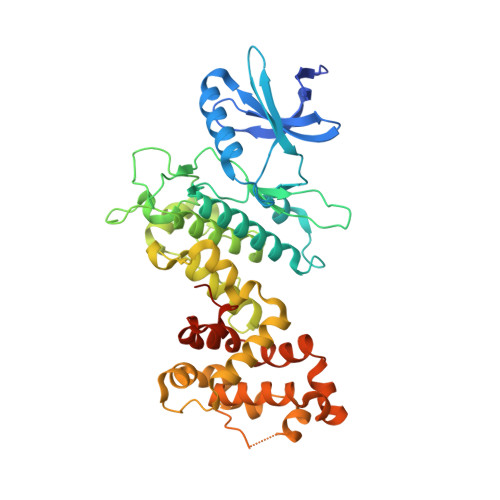Disruption of IRE1 alpha through its kinase domain attenuates multiple myeloma.
Harnoss, J.M., Le Thomas, A., Shemorry, A., Marsters, S.A., Lawrence, D.A., Lu, M., Chen, Y.A., Qing, J., Totpal, K., Kan, D., Segal, E., Merchant, M., Reichelt, M., Ackerly Wallweber, H., Wang, W., Clark, K., Kaufman, S., Beresini, M.H., Laing, S.T., Sandoval, W., Lorenzo, M., Wu, J., Ly, J., De Bruyn, T., Heidersbach, A., Haley, B., Gogineni, A., Weimer, R.M., Lee, D., Braun, M.G., Rudolph, J., VanWyngarden, M.J., Sherbenou, D.W., Gomez-Bougie, P., Amiot, M., Acosta-Alvear, D., Walter, P., Ashkenazi, A.(2019) Proc Natl Acad Sci U S A 116: 16420-16429
- PubMed: 31371506
- DOI: https://doi.org/10.1073/pnas.1906999116
- Primary Citation of Related Structures:
6URC - PubMed Abstract:
Multiple myeloma (MM) arises from malignant immunoglobulin (Ig)-secreting plasma cells and remains an incurable, often lethal disease despite therapeutic advances. The unfolded-protein response sensor IRE1α supports protein secretion by deploying a kinase-endoribonuclease module to activate the transcription factor XBP1s. MM cells may co-opt the IRE1α-XBP1s pathway; however, the validity of IRE1α as a potential MM therapeutic target is controversial. Genetic disruption of IRE1α or XBP1s, or pharmacologic IRE1α kinase inhibition, attenuated subcutaneous or orthometastatic growth of MM tumors in mice and augmented efficacy of two established frontline antimyeloma agents, bortezomib and lenalidomide. Mechanistically, IRE1α perturbation inhibited expression of key components of the endoplasmic reticulum-associated degradation machinery, as well as secretion of Ig light chains and of cytokines and chemokines known to promote MM growth. Selective IRE1α kinase inhibition reduced viability of CD138 + plasma cells while sparing CD138 - cells derived from bone marrows of newly diagnosed or posttreatment-relapsed MM patients, in both US- and European Union-based cohorts. Effective IRE1α inhibition preserved glucose-induced insulin secretion by pancreatic microislets and viability of primary hepatocytes in vitro, as well as normal tissue homeostasis in mice. These results establish a strong rationale for developing kinase-directed inhibitors of IRE1α for MM therapy.
- Cancer Immunology, Genentech, Inc., South San Francisco, CA 94080.
Organizational Affiliation:

















